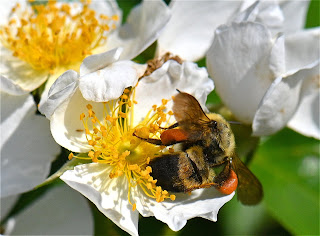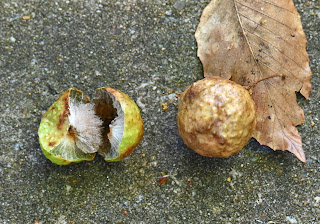Leader for today's Ramble: Dale
Link to Don's Facebook album for this Ramble. All the photos that appear in this report, unless otherwise credited, were taken by Don Hunter.
https://www.facebook.com/media/set?vanity=don.hunter.56&set=a.4987661561250369
https://www.facebook.com/media/set?vanity=don.hunter.56&set=a.4987661561250369
Number of Ramblers today: 31
Today's emphasis: Seeking what we find in the formal gardens.
Reading: Avis read a poem: Grass by Joyce Sidman. [link]
https://www.poetryfoundation.org/poems/54675/grass-56d2354b8c8e0
https://www.poetryfoundation.org/poems/54675/grass-56d2354b8c8e0
Today's Route: From the pergola to the sidewalk between the Ceramics bldg. and the Visitor's center then the first right down the steps to the formal garden then past the Pawpaws and down the steps following the walkway to the right and past several beds and across the stepping stone to the steps back up to the formal garden and back to the parking lot.
OBSERVATIONS:
Sidewalk between Ceramic museum and Visitor Center:
Swamp Milkweed is developing flower buds in the bed to the right of the sidewalk. This plant is a food source for the larval stage of the Monarch butterfly, so it will be worth checking in future rambles.
Sidewalk between Ceramic museum and Visitor Center:
 |
| Swamp Milkweed beginning to bloom. |
Swamp Milkweed is developing flower buds in the bed to the right of the sidewalk. This plant is a food source for the larval stage of the Monarch butterfly, so it will be worth checking in future rambles.
Monarchs are not the only insects that feed exclusively on milkweed species. There is a moth and several species of beetles that are specialized as milkweed feeders. Two true bugs, several aphids. The beetles and bugs are warningly colored in black and red.
Herb Garden:
An American Toad was captured in one of the mulched beds next to the steps leading into the Herb Garden. Toads, like all amphibians, have a moist skin through which they lose water by evaporation. They compensate for this water loss by rapid absorption of water through their belly skin; i.e., they find a wet spot and sit in it. Usually, they are most active at night when the relative humidity is higher. During the day they seek out moist areas like leaf litter or dense vegetation. Daily spraying of water at the Garden creates an ideal habitat for them.
Roly-poly, Wood louse, Pill Bug are just a few of the common names for a terrestrial crustacean that rolls up into a sphere when disturbed.
What is a crustacean? Most people are familiar with edible crustaceans like lobsters, crabs and crayfish (crawdads). But these are just a few of the crustaceans. Most are marine (living in the ocean) or aquatic (living in fresh water), but a few have made it to the terrestrial environment. Those that live on dry land need to have access to water because they get their oxygen through gills and gills are effective only if they are moist. (Land crabs need to return periodically to the sea to moisten their gills.) Pill Bugs reduce moisture loss like toads: by hiding under rocks or pieces of wood and only venturing forth when the relative humidity is high. That's why we saw a Pill Bug this morning on the brick surface of the Herb Garden. The Gardens are usually sprinkled early In the morning, raising the humidity of the bricks and allowing the Pill Bugs to venture forth in daylight for a short period of time.
 | |
| American Toad |
An American Toad was captured in one of the mulched beds next to the steps leading into the Herb Garden. Toads, like all amphibians, have a moist skin through which they lose water by evaporation. They compensate for this water loss by rapid absorption of water through their belly skin; i.e., they find a wet spot and sit in it. Usually, they are most active at night when the relative humidity is higher. During the day they seek out moist areas like leaf litter or dense vegetation. Daily spraying of water at the Garden creates an ideal habitat for them.
 | |
| Pill Bug |
Roly-poly, Wood louse, Pill Bug are just a few of the common names for a terrestrial crustacean that rolls up into a sphere when disturbed.
What is a crustacean? Most people are familiar with edible crustaceans like lobsters, crabs and crayfish (crawdads). But these are just a few of the crustaceans. Most are marine (living in the ocean) or aquatic (living in fresh water), but a few have made it to the terrestrial environment. Those that live on dry land need to have access to water because they get their oxygen through gills and gills are effective only if they are moist. (Land crabs need to return periodically to the sea to moisten their gills.) Pill Bugs reduce moisture loss like toads: by hiding under rocks or pieces of wood and only venturing forth when the relative humidity is high. That's why we saw a Pill Bug this morning on the brick surface of the Herb Garden. The Gardens are usually sprinkled early In the morning, raising the humidity of the bricks and allowing the Pill Bugs to venture forth in daylight for a short period of time.
 | |
| Monarch butterfly; upper wing surface |
 | ||||||||||||||||||||||
| Monarch butterfly; lower wing surface |
A Monarch butterfly was nectaring on some of the open flowers in the Herb Garden. Judging by its bright colors this was probably a first or second generation descendent of the Monarchs that overwintered in Mexico. How do we know this? The colors of a butterfly's wings are produced by millions of microscopic scales attached to the transparent wing surface, like shingles on a roof. When a butterfly flies a few scales are knocked off with each flap of the wings. The older the butterfly, the more scales it has lost and the less intense its color pattern is. Because the Monarch we saw this morning was still beautiful it was probably recently emerged from its chrysalis.
Is it a boy or girl Monarch butterfly? Male Monarch butterflies have a swelling on one of the dark veins on the upper side of the hind wings. This enlargement contains scales that carry a perfume the male will use to court a female. This so-called "scent patch" is not found in females. The difference is clearly seen in a photo from the Journey North website.
https://journeynorth.org/tm/monarch/id_male_female.html
Lizards
The bricks in the Herb Garden not only retain water when sprinkled, they also soak up sunlight during the day and radiate it away during the night. When the days are hot and the nights short the brick structures are favorite places for cold-blooded animals like grasshoppers and lizards to gather and warm up. For the lizards there is the added benefit of having their insect food supply on the bricks nearby. Today we found a Carolina Anole and an Eastern Fence lizard basking on the bricks and wooden benches. The fence lizard scooted away before most of the ramblers had a chance to see it, so I included a photo that Don took back in 2019.
 |
| Carolina Anole basking on bench |
 | |
| Eastern Fence Lizard |
The bricks in the Herb Garden not only retain water when sprinkled, they also soak up sunlight during the day and radiate it away during the night. When the days are hot and the nights short the brick structures are favorite places for cold-blooded animals like grasshoppers and lizards to gather and warm up. For the lizards there is the added benefit of having their insect food supply on the bricks nearby. Today we found a Carolina Anole and an Eastern Fence lizard basking on the bricks and wooden benches. The fence lizard scooted away before most of the ramblers had a chance to see it, so I included a photo that Don took back in 2019.
Heritage Garden
 | |
| Pawpaw fruit (only 2 seeds) |
 |
| Pawpaw flower; (usually dark maroon in color) |
The Pawpaw trees had a lot of flowers earlier this spring, but didn't produce much fruit. This can probably be attributed to a lack of pollinators. We were able to find one small fruit, but, as they are the same color as the leaves, we may have missed some. Don located a late flower, but its green colored petals are not typical.
 |
| Longleaf Pine |
Longleaf Pine once covered most of the southeastern USA. It was maintained by periodic, low intensity fires set by lightning. It's thick bark and rapid growth to put its upper reaches above the flames make is fire-resistant. It has been replaced by faster growing species and suppresion of fire that allows non-fire resistant species to outcompete it.
Flower Garden:
An Eastern Cottontail rabbit sampled the greens while ignoring us.
 |
| Eastern Cottontail rabbit |
 |
| Bumble bee nectar robbing Foxglove? |
Foxglove is planted in several locations in the Flower Garden and an assortment of bees are visiting all of them. The photo above looks like a Bumble bee cutting an opening at the base of a Foxglove flower to get access to nectar, bypassing the route through the open blossom.
 |
| Honeybee gathering pollen from Evergreen Rose. Note the pollen carried in the pollen baskets. |
Species Observed:
Swamp Milkweed Asclepias incarnata
American Toad Anaxyrus americanus
Pill woodlouse Family Armadillidiidae
Poppy Papaver sp.
Western Honey Bee Apis mellifera
Monarch Butterfly Danaus plexippus
Yaupon Holly Ilex vomitoria
Carolina Anole Anolis carolinensis
Pawpaw Asimina triloba
Evergreen Rose (tentative) Rosa sempervirens
Eastern Carpenter Bee Xylocopa virginica
Common Eastern Bumble Bee Bombus impatiens
Long-legged Fly Chrysotus sp.
Tumbling Flower Beetle Mordell sp.
Japanese Spirea Spirea japonica
Longleaf Pine Pinus palustris
Eastern Cottontail Rabbit Sylvilagus floridanus
Purple Foxglove Digitalis purpurea
California Poppy Eschscholzia californica













































